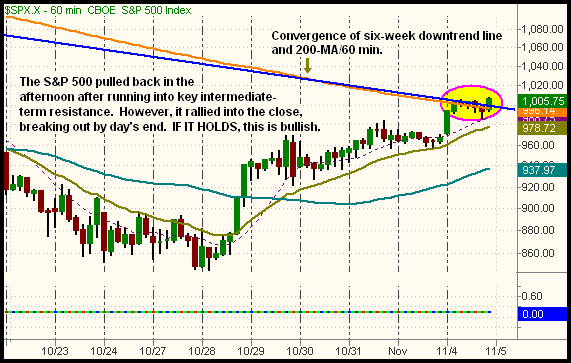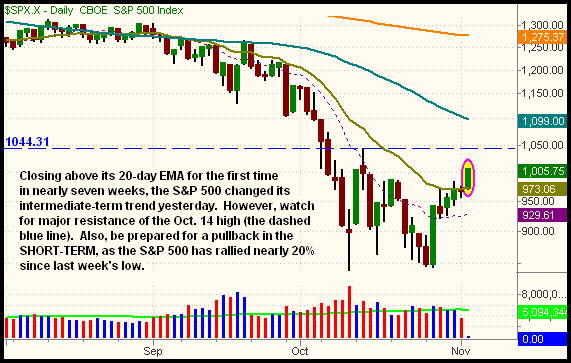The bulls don't want to see too steep of a retracement today that causes yesterday's trend reversals to fail.
The Nasdaq Composite scored its sixth straight day of gains yesterday, as the major indices logged an impressive round of gains on higher volume. The S&P 500 rallied 4.1%, the Dow Jones Industrial Average 3.3%, and the Nasdaq Composite 3.1%. The small-cap Russell 2000 and S&P Midcap 400 indices advanced 1.4% and 2.3% respectively. Large cap stocks played "catch up" to the leadership of small and mid-cap stocks over the past week. An afternoon reversal initially caused stocks to surrender about half of their intraday gains, but the bulls returned in the final hour, enabling the main stock market indexes to finish near their best levels of the day.
Volume swelled across the board, causing both the S&P 500 and Nasdaq Composite to register their second "accumulation day" within the past week. Total volume in the NYSE rose 27%, while volume in the Nasdaq similarly increased 29%. The higher turnover that followed Monday's price consolidation pointed to an increasing appetite for stocks amongst institutional traders. Lighter volume on flat to "down" days, and higher volume on "up" days, is a pattern stocks exhibit in healthy markets. Still, continue watching for any sudden bouts of distribution (losses on higher volume) that could pressure the fledgling rally attempt.
In the November 3, 2008 issue of The Wagner Daily, we looked at the key intermediate-term resistance levels of the S&P 500. Specifically, this was marked by convergence of its six-week downtrend line with the 200-period moving average on the hourly chart. Yesterday, the benchmark index broke out to close above that key resistance level, marking a significant change of the intermediate-term trend (if it holds). On the hourly chart below, notice how the S&P 500 initially backed off after running into its hourly downtrend line, but subsequently broke out into the close: 
Looking at the daily chart, notice how the S&P 500 has finally broken out above its 20-day exponential moving average (EMA) as well: 
Several times over the past week, the S&P tested its 20-day EMA on an intraday basis, but yesterday was the first time the index actually closed above its 20-day EMA since September 19. The breakout above the 20-day EMA, which correlated to a breakout above the six-week downtrend line, technically changes the intermediate-term trend. However, because the S&P 500 has rallied nearly 20% off last week's low without a pullback, one should be cautious of buying stocks and ETFs in the short-term.
Nearly all the ETF setups we pointed out in yesterday's newsletter broke out. Nevertheless, because the breakouts coincided with such a swift move in the broad market, we made a judgment call to take profits quickly, rather than take the chance of holding through a pullback. As such, we locked in a quick, 3-point gain on our iShares Brazil (EWZ) position. In the current market environment, being more nimble and pro-active than usual is advantageous. Since the major indices are in the process of changing their intermediate-term trends, the next short-term pullback will provide us with ideal entry points in new long positions. The only caveat is that the bulls don't want to see too steep of a retracement today that causes yesterday's trend reversals to fail. For a defensive play, don't forget about CurrencyShares Japanese Yen (FXY), which is an ideal buy entry above yesterday's high. Also, bond ETFs may be in play. We bought iShares Corporate Bond (LQD) yesterday.
Open ETF positions:
Long - DGP, LQD
Short - (none)
Deron Wagner is the Founder and Head Trader of both Morpheus Capital LP, a U.S. hedge fund, and Morpheus Trading Group, a trader education firm launched in 2001 that provides daily technical analysis of the leading ETFs and stocks. For a free trial to the full version of The Wagner Daily or to learn about Wagner's other services, visit MorpheusTrading.com or send an e-mail to deron@morpheustrading.com.